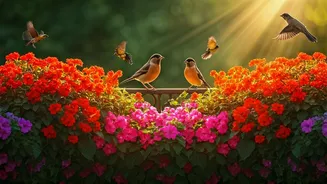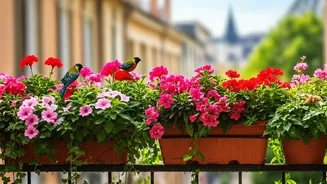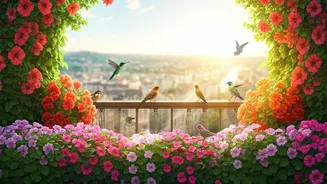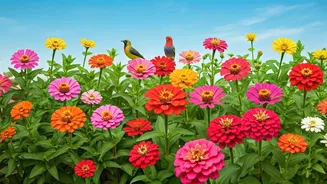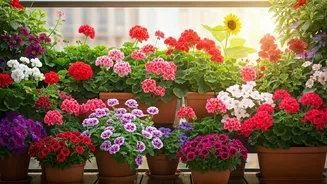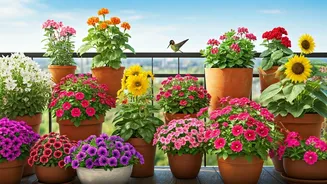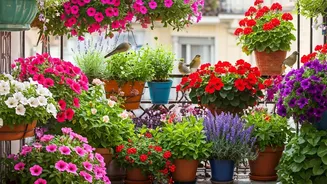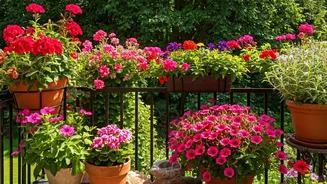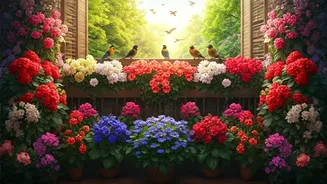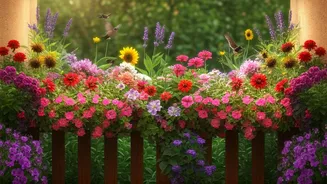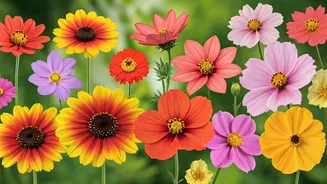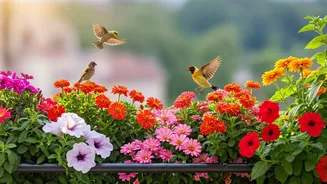Marigolds: Sunny Charms
Marigolds are a fantastic choice, known for their bright, cheerful appearance. Their vibrant yellow and orange hues are sure to liven up your balcony space.
These flowers are relatively easy to grow and maintain, which makes them an excellent choice for beginners. They not only add a splash of color but also attract small insects, providing a food source for birds, and this dual benefit makes them a winner for any balcony garden. Moreover, marigolds have a pleasant scent, contributing a delightful fragrance to your balcony.
Petunias: Colorful Cascades
Petunias, with their wide array of colors and cascading forms, are ideal for hanging baskets and containers. They create a visually stunning display and attract hummingbirds with their nectar-rich blooms. They are low-maintenance and will fill your balcony with a profusion of color. Petunias come in various shades, including purples, pinks, whites, and reds, ensuring you can tailor your balcony’s aesthetic. Their continuous blooming cycle keeps the color coming all season, and they are also relatively easy to propagate, allowing you to expand your garden over time.
Zinnias: Vibrant Hues
Zinnias offer a burst of vibrant color, and they are known for attracting butterflies and, indirectly, birds that enjoy the insects. Available in a wide variety of colors, zinnias can easily fit any design, and their long blooming season provides continuous interest. These flowers are relatively straightforward to grow and thrive in sunny locations, making them perfect for balconies with ample sunlight. Moreover, they are excellent for cutting, meaning you can bring the beauty of your balcony indoors as well. The vibrant and bold colors of zinnias create an energetic atmosphere on any balcony.
Sunflowers: Miniature Giants
While full-sized sunflowers may be too large for some balconies, dwarf varieties are perfect for containers. Sunflowers are iconic for their cheerful appearance, providing seeds that are a favorite food source for many bird species. Growing sunflowers provides a direct food source, thus contributing to a thriving ecosystem on your balcony. Even the smaller varieties make a big impact, adding height and interest to your display. Plus, watching sunflowers grow is a rewarding experience, providing both visual appeal and a sense of connection with nature.
Nasturtiums: Edible Delights
Nasturtiums are not only beautiful with their vibrant flowers but are also edible, offering a unique element to your balcony garden. Their flowers and leaves have a peppery taste, adding flavor to salads. They are low-maintenance, easy to grow, and attract both hummingbirds and insects. Nasturtiums also act as a natural pest repellent, helping to protect other plants. Their trailing habit makes them suitable for hanging baskets or containers, and their bright colors add cheerfulness to any balcony. The combination of beauty, edibility, and ease of care makes them an attractive option.
Salvia: Hummingbird Magnets
Salvia varieties, especially those with red flowers, are known hummingbird magnets. Their tubular flowers are perfectly shaped to attract hummingbirds seeking nectar. Salvia comes in various forms and colors, offering versatility for your balcony design. They prefer full sun and well-drained soil, making them suitable for many balcony conditions. By growing Salvia, you’re not just beautifying your space; you are also providing a valuable food source for these fascinating birds. The striking colors and distinctive form of Salvia can make your balcony a focal point.
Coneflowers: Seed-Bearing Beauties
Coneflowers, with their daisy-like appearance and prominent cones, are visually striking and provide seeds that birds love. They are relatively easy to grow and attract various pollinators, increasing the biodiversity of your balcony garden. Coneflowers come in a range of colors, from the classic purple to pinks and whites. They also have a long blooming season, extending the period of beauty on your balcony. Moreover, their sturdy stems make them a good option for windy balconies. These plants provide a valuable food source and aesthetic charm to your balcony setup.
Lantana: Butterfly Attractor
Lantana is another fantastic option, often used to draw butterflies and, in turn, attract birds to your balcony. Its bright clusters of flowers come in multiple colors and offer a continuous display. They are drought-tolerant, which makes them easy to maintain, and the flowers provide nectar for pollinators. Lantana's ability to attract butterflies makes your balcony lively. The variety of colors and easy-care nature makes them a perfect addition. Lantana adds vibrancy and creates a vibrant ecosystem on the balcony.
Pansies: Cool-Season Charm
Pansies are a great choice for cooler months, adding color to your balcony during the transitional seasons. Their cheerful faces come in a wide range of colors and patterns, providing visual interest. They thrive in partial shade and are relatively easy to care for, making them suitable for various balcony conditions. Birds are drawn to the insects that are attracted to pansies, so these add more activity to the scene. Pansies can also tolerate colder temperatures, providing color to your balcony from late autumn through spring. They will bring color and charm to your balcony.
Lavender: Fragrant Attraction
Lavender, with its beautiful purple flowers and captivating fragrance, is a great choice. The scent will not only appeal to you but also attract pollinators and small insects that birds eat. Lavender thrives in sunny locations and well-drained soil, making it perfect for balconies. Lavender offers beauty and functionality to your space. Moreover, the dried lavender can be used for various purposes, adding another dimension to your balcony's value. Lavender's aroma and charm makes it a winning choice for balconies.
